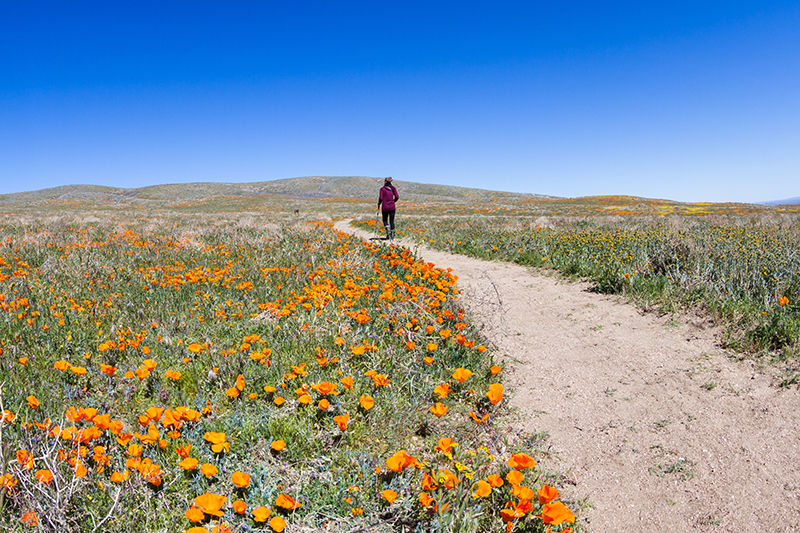The Antelope Valley Poppy Reserve, located 15 miles west of Lancaster, is an 1,800-acre state reserve “located on California’s most consistent poppy-bearing land.”
On April 2, the website’s “Bloom Status” noted: “The season appears to have ended early, as last month’s rains came too late to sustain the bloom that had barely started.”
Or, as the lady behind the register in the gift shop observed to a fellow poppy seeker, “It just didn’t happen this year.”
I knew that before I made a field trip to the Poppy Reserve, on March 31. But visiting on an off-year, I figured, would be its own, different kind of salute to the California Poppy (Eschscholtzia californica), our state flower since 1903.
At the 2,000-square-foot Jane S. Pinheiro Interpretive Center (and gift shop), I learned about “The Great Poppy Lady,” an Antelope Valley resident and self-taught wildflower artist. In the 1940s, Jane painted watercolors of the local wildflowers that were declared by a UC Davis botanist to be “botanically correct and really a treasure.”
In 1950, she and a neighbor started the annual Quartz Hill Almond Blossom Festival. Realizing even back then that urban development would threaten the vast swaths of land on which desert trees and wildflowers grew, by 1960 she had convinced the State Assembly to set aside 2,720 acres — now Saddleback Butte State Park — to protect the Joshua Tree.
Jane and other members of the Lancaster Women’s Club then installed the first Antelope Valley Wildflower Center — complete with small vases of identified specimens and Jane’s watercolors — in a rented building along Sierra Highway. She was instrumental in raising the funds for the Poppy Reserve. Her efforts ranged from appeals to the president of the State Parks Foundation to the institution of a “Pennies for Poppies” program in the local schools that raised $1,400. The park was dedicated on April 24, 1976.
Spanish sailors called the fields of shimmering gold poppies that used to blanket the state in early spring La Sabanilla de San Pasqual — the Altar-Cloth of San Pasqual. In the 1700s these “rivers of gold” — centered in what is now known as Pasadena, Altadena and Sierra Madre — stretched 25 miles to the Pacific.
The day I visited, by contrast, I walked half a mile along one of the many trails before seeing a single specimen. I’ve seen more poppies in neighbors’ yards on a walk to my branch library in Pasadena. While the brochure pictured photos of snow-capped mountains and endless vistas of pure shining orange, I contented myself with a shot of a lone, tattered bloom on an expanse of bare gravel.
But then I came upon a scattered clump here and there and, just because the blooms I’d come for were so scarce, I gazed upon the poppy in a way I never had before. The satin petals to which seem to have been applied the lightest coat of varnish. The way the lambent flame-orange color darkened near the center — the California Poppy is sometimes called Copa de Oro (Cup of Gold). The slender cone-like unopened blossoms, like tight twists of crepe paper.
So I exulted in my hike. I had the tawny paths mostly to myself. Hawks soared overhead. The grass, with undertones of amethyst, rippled in the breeze like the hide of some great animal. Small pale violet butterflies with dark-spotted wings fluttered at knee level. Lizards with intricately-patterned backs zoomed in and out of the burrows of some larger animal.
The preserve boasts as well black-tailed jackrabbits, burrowing owls, bobcats, painted lady butterflies, rattlesnakes and the pronghorn antelope. In a banner season, other flowers include owl’s clover, cream cups, blue dicks, hairy lotus and the red stem filaree.
FOMO (fear of missing out) — “anxiety that an exciting or interesting event may currently be happening elsewhere, often aroused by posts seen on a social media website” — is a contemporary cultural phenomenon. But what with the beauty that surrounded on every side, the operative point wasn’t that the fields this year weren’t blanketed with poppies; the operative point was that a single poppy exists, or did exist, or will exist, anywhere, ever.
I walked as far as I could in a northwesterly direction from the parking lot, to Antelope Butte Vista Point, a distance of three miles or so, and gazed out over God’s handiwork, and prayed the Angelus.
“We are sowing the seeds of love,” Dorothy Day observed, “and we are not living in the harvest time.” That’s true of every age, of every human being.
I prayed that next year, other people will get to see the poppies.
Heather King is a blogger, speaker and the author of several books.

